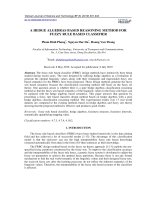A natural deep eutectic solvent - protonated L-proline-xylitol - based stationary phase for gas chromatography
Bạn đang xem bản rút gọn của tài liệu. Xem và tải ngay bản đầy đủ của tài liệu tại đây (1.01 MB, 8 trang )
Journal of Chromatography A 1676 (2022) 463238
Contents lists available at ScienceDirect
Journal of Chromatography A
journal homepage: www.elsevier.com/locate/chroma
A natural deep eutectic solvent - protonated L-proline-xylitol - based
stationary phase for gas chromatography
Malwina Momotko a,∗, Justyna Łuczak a,c, Andrzej Przyjazny b, Grzegorz Boczkaj c,d,∗
a
Gdansk University of Technology, Faculty of Chemistry, Department of Process Engineering and Chemical Technology, 80 – 233 Gdansk,
G. Narutowicza St. 11/12, Poland
b
Kettering University, 1700 University Avenue, Flint, MI 48504, USA
c
Advanced Materials Center, Gdansk University of Technology, 80 – 233 Gdansk, G. Narutowicza St. 11/12, Poland
d
Gdansk University of Technology, Faculty of Civil and Environmental Engineering, Department of Sanitary Engineering, 80 – 233 Gdansk, G. Narutowicza
St. 11/12, Poland
a r t i c l e
i n f o
Article history:
Received 18 February 2022
Revised 9 June 2022
Accepted 10 June 2022
Available online 12 June 2022
Keywords:
Natural deep eutectic solvent (NADES)
Separation techniques
Volatile organic compounds (VOCs)
Hydrogen bond
Molecular interactions
a b s t r a c t
The paper presents a new kind of stationary phase for gas chromatography based on deep eutectic solvents (DES) in the form of a mixture of L-proline (protonated with hydrochloric acid) as a hydrogen bond
acceptor (HBA) and xylitol as a hydrogen bond donor (HBD) in a molar ratio of HBA:HBD 5:1. DES immobilized on a silanized chromatographic support was tested by gas chromatography (GC) in order to determine its resolving power for volatile organic compounds. Studies have demonstrated the suitability of
this type of DES as a stationary phase for GC. The Rohrschneider-McReynolds constants were determined
for the synthesized DES, revealing that it is a polar stationary phase ( ( I) = 1717). The selectivity of
DES is influenced by the presence of hydroxyl groups in the xylitol structure capable of forming hydrogen bonds of a donor nature and the proton acceptor properties of the protonated L-proline structure.
The presence of additional interactions is brought about by the presence of the carboxyl group. As a result, the retention of alcohols is several times higher (200-670%) than the expected value based on their
boiling points. A significant increase in retention (400-970%) was also found for pyridine derivatives. The
developed DES stationary phase is characterized by very good repeatability of retention and stability (up
to 140°C). The efficiency of the prepared columns (630 0-1130 0 theoretical plates/m) and the selectivity
of the DES stationary phase are competitive with the commercial products.
© 2022 The Author(s). Published by Elsevier B.V.
This is an open access article under the CC BY license ( />
1. Introduction
Deep eutectic solvents have recently been the subject of very
extensive research on their applications in various areas of science
and technology. The possibility of synthesizing DESs showing specific intermolecular interactions with numerous groups of chemical compounds constitutes their great potential in separation techniques, such as extraction media [1,2], absorbents [3] and membrane components [4–6]. Also in chromatographic techniques, DES
gained high attention [7]. In literature, often a term such as DES
based stationary phases is used. However, analysis of such reports
reveals that DESs are not involved in final stage, i.e. during application of such materials in separation techniques. Mostly, they
were used at synthesis stage (as solvents or additives) to obtain
∗
Corresponding author.
E-mail addresses: (M. Momotko),
(G. Boczkaj).
materials with improved properties, such as modified silica gel [8–
12]. In other studies, it was claimed that addition of DES provide
improved dispersion of nanomaterials subjected for functionalization [13,14]. DESs proved to be useful (as specific pore size formers) during synthesis of packings for size exclusion chromatography (SEC) [15–18]. In other approaches, DES is present during polymerization stage, resulting in formation of new sorptive material
[19,20]. It is clear that obtained stationary phases are not liquid
and primary DES does not possess its “liquid” properties in final
material. It is worth to mention, that in most attempts, the final
material lacks of DES components. In terms of liquid chromatography (LC), DESs were used as additives to mobile phase [21,22] as
well as main mobile phase component [23,24]. Still, the literature
about application of DESs as stationary phases is scarce.
So far, it has been shown that DES can be used in the form
of a mixture of heptadecanoic acid and tetrabutylammonium chloride in a mole ratio of HBD:HBA 2:1 as a stationary phase for gas
chromatography (GC) [25]. The obtained columns were character-
/>0021-9673/© 2022 The Author(s). Published by Elsevier B.V. This is an open access article under the CC BY license ( />
M. Momotko, J. Łuczak, A. Przyjazny et al.
Journal of Chromatography A 1676 (2022) 463238
ized by good efficiency and stability of retention parameters during
long-term use. The McReynolds constant values for the synthesized
DES phase were compared with the literature values for commercially available stationary phases, revealing that a material with a
different selectivity was obtained. The sum of the McReynolds constants is equal to 1174 which indicates that the synthesized DES
stationary phase has a medium polarity. The results of this work
expanded the applicability of deep eutectic solvents. The possibility of modifying the properties of DES by changing one of its components or by adding an extra solute offer great opportunities for
the preparation of new stationary phases.
Countless combinations of HBA and HBD allow preparation of
DESs having high, often unique, selectivity due to the complex nature of sorption interactions between DES and the separated compounds. The use of DESs in many areas of separation techniques
is possible due to the similarity of their physicochemical properties to those of classic solvents. However, in many cases DESs are
prepared from volatile or thermally labile compounds, precluding
most of them as potential components for stationary phases for
GC. As a result of these limitations, DESs obtained using protonated
L-proline as the hydrogen bond acceptor (HBA) and xylitol as the
hydrogen bond donor (HBD) were selected for this study. As both
components have a natural origin, this type of DES can be named
as Natural Deep Eutectic Solvents (NADES) [24]. Preliminary studies were performed with DESs synthesized using L-proline protonated with three different acids (hydrochloric, sulfuric and phosphoric). Subsequently, the DES stationary phase based on L-proline
protonated with hydrochloric acid was selected for further work,
as it turned out to be the only one suitable as a stationary phase
for GC.
silanized wool. A Clarus 500 gas chromatograph (Perkin Elmer,
Waltham, USA) with a split/splitless injection port and a flame ionization detector (FID) was used for all GC studies performed in this
paper. The GC instrument was equipped with an autosampler. A
PGX-H2 500 generator (Perkin Elmer, Waltham, USA) was used as
hydrogen supply.
2.3. Procedure
2.3.1. Synthesis of DES
The synthesis of the deep eutectic solvent involved dissolving
L-proline in an acid solution (the amount of acid with respect to
L-proline was equimolar). Next, a predetermined amount of xylitol was added to the solution. Thus prepared solution was placed
in a rotary evaporator and water was distilled off under reduced
pressure. For the selected DES composition, two batches of DES
were independently synthesized to evaluate the repeatability of
their properties. Studies on the synthesis of this type of DESs and
their physicochemical characteristics were the subject of a separate
paper [26].
2.3.2. Preparation of DES based stationary phases and GC columns
Decantation from methanol was used to remove subsized particles from commercial Chromosorb W-AW-DMCS 80-100 mesh
(Johns-Manville, Denver, United States). Subsequently, the support
was dried in a rotary evaporator (removal of methanol) and activated in a vacuum oven at 230°C. The activation stage lasted 240
minutes. After the support was cooled to about 30°C, it was taken
out of the oven and instantly added to a flask containing homogeneous mixture of DES and methanol (1 g DES in 150 mL of
methanol). The suspension was equilibrated by mixing in a rotary
evaporator for 30 min followed by evaporation of the solvent.
The stationary phase prepared in this way was then used to
pack GC columns using the dry pack method. Following the packing, each prepared column was conditioned at 30°C in the flow of
inert gas (nitrogen, 40 mL/min) for 1 hour. Next, the column temperature was ramped from 30°C to 110°C at 1°C/min. Finally, the
column outlet was joined with the flame ionization detector and
the column was thermostated in 110°C. This conditions were maintained until stable signal from the detector was observed.
2. Materials and methods
2.1. Materials
The investigated DES (L-proline, xylitol) was prepared from
reagents of >99% purity (Sigma Aldrich, Burlington, USA) while
hydrochloric, phosphoric and sulfuric acid were of analytical
reagent grade (POCH, Gliwice, Poland). A Chromosorb W AW-DMCS
(80/100 mesh) chromatographic support (Johns-Manville, Denver,
United States) was used as DES support. DES was deposited on the
support from methanol (analytical reagent, POCH, Gliwice, Poland).
A thin-walled steel tubing (1/8” ID, L = 2.70 m) were used as
packed columns. A silanized glass wool (Supelco, Bellefonte, USA)
was used to hold the stationary phase in the columns (small portions of the wool were placed at the both ends of the column).
Standard test mixtures of volatile organic compounds (VOCs)
(Sigma Aldrich, Burlington, USA) and a mixture of n-alkanes in
the range of n-C5 to n-C17 (Analytical Controls, Houston, USA)
were used in the GC tests of the obtained columns. Typically, test
compounds were dissolved in carbon disulfide (analytical reagent,
Merck, Darmstadt, Germany). The gases in the GC analysis included
nitrogen (N5.0, Linde Gas, Gdynia, Poland) as the mobile phase
(carrier gas), while the FID detector gases were hydrogen (N5.5,
from a hydrogen generator) and air (N5.0, Linde Gas).
2.3.3. Characterization of the DES based GC stationary phase
Test standards solutions (ca. 500 ppm) in CS2 were used in the
studies. A methane (a 10 ppm mixture in nitrogen) was used to
determine dead time.
Splitless mode was used in all injections. The injection volume
was 1 μL for all solutions and 0.1 mL for gas mixtures. Linear velocity of the carrier gas was 4.21 cm/s. Both the injection port
and FID were kept at 300°C. A temperature program was used in
all chromatographic separations. The initial oven temperature was
35°C (held for 2 min), followed by a ramp to a final temperature
(110°C) with the rate of increase of 5°C/min. The final oven temperature was held for 20 min.
Retention times and the number of theoretical plates (N) for
standards were determined from the GC-FID chromatograms using
TotalChrom v.6.3 software (Perkin Elmer, Waltham, USA). Retention
(k) and selectivity factors (α) were then calculated from the obtained values. The obtained retention times (tr,real ) were next used
to compare them with predicted retention time values for a nonpolar stationary phase – they were calculated using boiling point (bp)
values of the analytes (tr,bp ). The predicted retention time values
were obtained on the basis of determined relationship between retention time values and boiling point values (tr,bp = f(bp)) for nalkanes used as test probes. The obtained data were also used to
calculate the relative percent deviation of the retention time values
(R%).
2.2. Apparatus
All chemicals were precisely prepared on the weight basis using a AS.310.R2 analytical balance (Radwag, Radom, Poland). A
06-MSH-PRO-T magnetic stirrer (Chemland, Stargard, Poland) was
used to prepare DESs and their solutions in methanol. A Rotavapor
R-300 rotary evaporator (Buchi, Flawil, Switzerland) was employed
to immobilize the DES on the support. To pack the columns under vacuum assistance a CRVpro4 vacuum pump (Welch, Ilmenau,
Germany) was connected to one end of the column plugged with
2
M. Momotko, J. Łuczak, A. Przyjazny et al.
Journal of Chromatography A 1676 (2022) 463238
Additionally, based on protocol proposed by Davis, an interaction coefficients (Ip ) were determined [27]. The Ip was obtained as
the calculated difference between tr,real and the theoretical retention for a specified substance (this value was calculated according
to equation (1)).
I p = logtr,real,i · 100 − (A · Mi + B )
composition 205-228°C) [26] protonated with three different mineral acids (sulfuric, phosphoric and hydrochloric) was used as HBA
and xylitol (melting point 92°C) was used as HBD in a mole ratio
HBA:HBD - 5:1. Studies on the synthesis of DESs based on protonated L-proline have shown that DES can be obtained for each of
the three acids listed above [26]. It is worth to mention, that according to previous studies [26], protonation of L-proline is mandatory to obtain this type of DESs. Pristine L-proline does not form
DESs with xylitol. All three mineral acids mentioned above, provide successful protonation of proline, which in this form acts as
HBA and forms DESs with Xylitol.
During preliminary investigations, GC columns based on all
three DESs were prepared. However, the initial testing of the synthesized phases revealed that in the case of the phases obtained by
protonating L-proline with sulfuric and phosphoric acid, there is a
considerable tailing of chromatographic peaks and a low efficiency
of the columns prepared. On the other hand, in the case of DES
obtained using L-proline protonated with hydrochloric acid, symmetrical chromatographic peaks and very good column efficiency
were observed. This is an important observation, worth verification during future attempts to synthesize stationary phases for GC
based on HBA obtained by protonation of the amino group with
mineral acids.
With the given composition (HBA-HBD 5:1) and using the protonation of L-proline with hydrochloric acid, a clear colorless eutectic liquid is formed with a melting point of -37°C [26].
Chromatographic assays carried out using the synthesized GC
stationary phase allowed determination of typical properties of
stationary phases with respect to volatile organic compounds differing in functional groups and volatility as well as saturated hydrocarbons (n-alkanes) commonly used in GC as reference compounds. n-Alkanes do not show specific interactions with the stationary phase, and their retention depends only on their volatility.
In this way, it can be determined – on the basis of the increased
retention of individual VOCs – whether the tested stationary phase
allows for specific sorptive interactions with test substances having
specific functional groups.
(1)
where:
A- the slope of calibration curve for n-alkanes in the form i
100∗ log(tr ) = f (M)
B- the intercept of calibration curve for n-alkanes in the form
100∗ log(tr ) = f (M) log(tr,real,i ) – common logarithm of retention
time of analyte i
Mi – molar mass of analyte i [g/mol]
In this way, the retention deviations were determined both with
respect to boiling point value as well as the molar mass of the
analytes.
2.3.4. Evaluation of stability of DES based stationary phase and
repeatability of manufactured columns
Repeatability and stability of column performance were evaluated using retention time values obtained as triplicate analysis of
the same mixture analyzed in given column (analysis-to-analysis)
and after 50 chromatographic runs, respectively.
Column-to-column repeatability was determined by comparing
retention characteristics of two independently prepared columns.
For each column, an independent synthesis of DES at identical
conditions was performed. In this case comparison of McReynolds
constants was used as evaluation criteria.
3. Results and discussion
3.1. Suitability of DESs as stationary phases for GC
The search for new applications of DESs suitable to be used as
stationary phase for GC faces considerable challenges. At present,
the synthesis of new types of DESs is highly probable – the number of potential HBA and HBD is huge and so far many possible
combinations have not been studied yet. However, the criteria that
DESs must meet to be used as stationary phases for GC narrow
these possibilities. Obviously, volatile compounds cannot be used
and should be removed from consideration. The second criterion is
thermal stability – depending on the applications of the developed
stationary phase. In the case of separation of volatile organic compounds (VOCs), satisfactory operating temperatures of the columns
are in the range of 30-100 °C. On the other hand, in order to ensure effective separation of polycyclic aromatic hydrocarbons, the
required thermal stability of the stationary phase should be at least
250 °C. For these reasons, the spectrum of chemicals that can form
DESs and meet the above requirements is already very limited.
DES, whose components (Fig. 1) meet the above requirements,
were selected for this study. L-proline (melting point/thermal de-
3.2. Characteristics of prepared packed column and selectivity of DES
stationary phase
Columns used in this study were 2.7 m long and their diameter was 1/8”. The DES used in this study was completely soluble
in methanol, which provided good conditions for DES immobilization on the chromatographic support using a static technique during solvent evaporation from the suspension in a rotary evaporator.
The DES content of 10% (w/w) of the support was used. This is a
commonly used loading amount of stationary phase for this type
of chromatographic support. No aggregations of the particles or
deposits on the inner walls of the round-bottom flask were observed. DES coating onto the support and packing of the column
were handled the same way as are typical liquid stationary phases
for GC. The column packing was added into the column in small
portions assuring a free fall of the particles in the column.
The efficiency of the obtained packed columns was determined
for undecane (n-C11 ) and dodecane (n-C12 ) as the number of theoretical plates and equal to 17072 and 30635, respectively, which
should be considered a very good result for packed columns.
Examples of separation of mixtures of n-alkanes and sulfides
are shown in Figs. 2 and 3. Fundamental physicochemical properties and retention parameters for the analytes tested are listed in
Table 1.
The inspection of the data compiled in Table 1 reveals that the
obtained stationary phase based on DES has an interesting selectivity, which can be interpreted by the possible sorption interactions with compounds forming DES. Protonated proline can ex-
Fig. 1. Structural formulas of chemical compounds used for synthesis of DES a) protonated by hydrochloric acid L-proline b) xylitol.
3
M. Momotko, J. Łuczak, A. Przyjazny et al.
Journal of Chromatography A 1676 (2022) 463238
Fig. 2. Separation of n-alkanes (mixture containing ca. 8.3% of each standard from n-pentane to n-heptadecane without n-tridecane in carbon disulfide, chromatographic
conditions as described in section 2.5). Injection volume 1 μL in splitless mode. Temperature program: 35°C (held for 2 min.), then ramped to 110°C at 5°C/min. 1 – n-C5 /nC6 ; 2 – n-C7 ; 3- n-C8 ; 4- n-C9 ; 5- n-C10 ; 6- n-C11 ; 7- n-C12 ; 8- n-C14 ; 9- n-C15 ; 10- n-C16 ; 11- n-C17 .
Fig. 3. Separation of sulfides (mixture containing ca. 0.5% of each standard in carbon disulfide (CS2 ), chromatographic conditions as described in Section 2.5). Injection
volume 1 μL in splitless mode. Temperature program: 35°C (held for 2 min.), then ramped to 110°C at 5°C/min. 1 – CS2 ; 2 – dimethyl disulfide; 3- dipropyl sulfide; 4- dibutyl
sulfide.
hibit strong proton-acceptor interactions (which is obvious due to
its role as HBA in DES), but also proton-donor (presence of OH group in carboxyl group of proline, protonated nitrogen atom
in proline) and n-π interactions (presence C=O group in carboxyl
group of proline) and, to a lesser extent, dispersion interactions. On
the other hand, xylitol should exhibit primarily interactions characteristic of the hydroxyl group. The resultant selectivity of the DES
used in GC, however, is not obvious, as the mole ratio of L-proline
to xylitol (5:1) of the eutectic mixture indicates that each hydroxyl
group of the xylitol molecule should interact with one protonated
L-proline molecule. Then, the carboxyl group of L-proline would
be expected to be responsible for the interaction with the analytes
being separated. The stationary phase, however, is a liquid and it
should be expected that the instantaneous form of DES and the
arrangement of molecules in space can deviate from the assumed
form – the existence of DES is mainly based on hydrogen bonding
interactions and the presence of analyte molecules will result in
competitiveness of these compounds with the DES components. In
a sense, the separation mechanism can be compared to that taking
place in liquid chromatography – where eluent components and
analytes compete for the access to active sites of the stationary
phase. This again demonstrates the enormous potential of DESs as
4
M. Momotko, J. Łuczak, A. Przyjazny et al.
Journal of Chromatography A 1676 (2022) 463238
Table 1
Retention data of volatile organic compounds tested on DES.
b.p. [°C]
M [g/mol]
Compound
tr[min]
Aromatic hydrocarbons
0.71
1
1.7
0.99
3.5
6.07
80.1
110.6
136
144
159
183
78.11
92.14
106.17
106.17
120.19
134.22
Benzene
Toluene
Ethylbenzene
o-Xylene
Propylbenzene
Butylbenzene
97
98
102
116
119
138
156
160
175
205
60.06
74.12
88.15
74.12
88.15
88.15
102.17
100.16
116.2
108.14
1-Propanol
2-Butanol
t-Amyl alcohol
1-Butanol
2-Pentanol
1-Pentanol
1-Hexanol
Cyclohexanol
1-Heptanol
Benzyl alcohol
92
101
124
127.6
131
140
147
155.6
169
202
86.13
86.13
114.19
100.16
84.12
100.12
114.19
98.14
112.17
101.24
Methyl isopropyl ketone
2-Pentanone
Diisopropyl ketone
2-Hexanone
Cyclopentanone
Acetylacetone
3-Heptanone
Cyclohexanone
3-Methylcyclohexanone
Acetophenone
84
112
116
133
84.14
98.17
98.17
112.19
Thiophene
2-Methylthiophene
3-Methylthiophene
2-Ethylthiophene
k
tr
theor.[min]
0.3
0.8
2.0
0.8
5.3
9.8
0.50
1.07
2.09
2.53
3.50
5.55
66.64
45.07
25.98
26.04
18.49
30.11
42.87
-6.68
-18.63
-60.79
-0.13
9.41
5.0
9.4
7.9
9.9
11.2
14.6
20.2
17.9
24.6
52.2
0.74
0.76
0.84
1.24
1.35
2.19
3.29
3.58
4.80
7.99
355.58
670.36
494.15
391.23
406.14
299.03
260.96
195.44
198.22
273.30
-∗
96
86
98
100
111
115
113
102
147
0.9
1.2
2.3
3.4
2.7
3.1
6.6
5.6
9.8
17.4
0.64
0.82
1.54
1.69
1.85
2.30
2.70
3.26
4.28
7.62
61.24
51.18
20.64
45.89
11.05
0.00
56.82
13.68
41.29
35.05
19
27
18
50
50
47
54
68
72
80
0.3
0.8
0.9
2.0
0.54
1.11
1.24
1.94
38.21
-10.24
-13.97
-12.40
5
13
16
17
0.4
0.6
3.4
3.3
12.3
12.1
13.7
0.63
1.05
3.02
2.41
6.05
6.59
7.38
28.78
-14.60
-18.22
-0.86
23.09
11.61
11.77
6
9
22
12
14
8
-14
2.1
5.5
10.9
10.2
25.3
1.58
3.02
4.22
4.71
13.20
9.94
19.85
58.37
32.70
11.34
29
38
82
33
14
22.3
20.9
28.1
30.3
1.22
2.53
2.58
3.50
972.44
385.92
531.65
400.77
110
72
85
64
3.4
45.8
39.1
1.89
7.62
8.75
28.90
243.73
156.77
12
65
61
tr [%]
Ip
Alcohols
3.35
5.8
5.01
6.11
6.8
8.8
11.9
10.6
14.3
29.8
Ketones
1.04
1.24
1.9
2.47
2.05
2.30
4.24
3.71
6.05
10.29
Thiophene and its alkylated derivatives
0.74
1
1.07
1.7
Sulfides and disulfides
91
110
152
142
188
193
200
90.19
94.2
118.24
122.25
146.29
150.31
178.36
Diethyl sulfide
Dimethyl disulfide
Diethyl disulfide
Dipropyl sulfide
Dibutyl sulfide
Dipropyl disulfide
Di-t-butyl disulfide
0.81
0.9
2.47
2.39
7.45
7.35
8.25
125
152
168.3
174
240.56
104.21
118.24
110.18
132.27
174.35
1-Pentanethiol
1-Hexanethiol
Thiophenol
1-Heptanethiol
1-Decanethiol
1.74
3.62
6.69
6.25
14.7
Thiols
Pyridine and derivatives
115.2
144
145
159
79.1
93.13
93.13
107.07
Pyridine
3-Methylpyridine
4- Methylpyridine
2,4- Dimethylpyridine
132
202
211
89.09
123.11
120.15
Nitropropane
4-Methylbenzaldehyde
Nitrobenzene
13.1
12.3
16.3
17.6
Other compounds
∗
2.4
26.2
22.5
value of the molar mass used for the calculation of the parameter outside the range of the reference compounds (n-alkanes).
stationary phases due to the wide possibility of modifying sorptive properties, and therefore selectivity of the obtained stationary
phases.
The retention of individual groups of chemical compounds confirms the above assumptions: high retention compared to saturated
hydrocarbons of low polarity is exhibited by polar compounds:
5
M. Momotko, J. Łuczak, A. Przyjazny et al.
Journal of Chromatography A 1676 (2022) 463238
– alcohols having specific interactions through the hydroxyl
group. In this case, interactions can take place with protonated
L-proline as well as with xylitol;
– pyridine and its alkyl derivatives are capable of proton-acceptor
interactions. In this case, interactions with the carboxyl group
of L-proline, with the hydrogen atom of protonated L-proline
and with the hydroxyl groups of xylitol should be expected. At
the same time, the synthesized DES provides a good separation
of analytes within each group.
An inspection of the differences of retention index values with
respect to squalane ( I) for individual test substances revealed
that the synthesized DES-based phase has the strongest interactions with pyridine ( I = 661), unprecedented for commercially
available stationary phases, followed by strong interactions with
nitropropane and 1-butanol ( I values equal to 461 and 417, respectively). At the same time, according to the McReynolds constants, the investigated phase does not exhibit selectivity for aromatic compounds relative to squalane ( I = 0). Evidently, the selectivity of the developed stationary phase is different from that
of the commercially available stationary phases [26] and the previously developed stationary phase based on DES. Furthermore,
presence of L-proline makes some potential for application of this
stationary phase for chiral separations. This aspects will be further studied in future papers about DES-based stationary phases
for GC.
The investigated stationary phase also exhibits a significant selectivity in terms of occurrence of:
– alkyl substituents – compounds without alkyl groups have
stronger interactions with DES (values of tr ) than their alkylated derivatives. This effect is observed, among others, for aromatic hydrocarbons (benzene vs alkyl derivatives), thiophene
and its alkyl derivatives as well as pyridine and its derivatives;
– aromatic ring – increased retention for compounds with a
phenyl group in their structure. This effect is noticeable for
thiophenol (compared to aliphatic thiols) as well as for nitrobenzene and 4-methylbenzaldehyde.
3.4. Retention stability, analysis-to-analysis and column-to-column
repeatability
As mentioned earlier, the stationary phase for GC must ensure
the repeatability of retention of the separated chemical compounds
during the repeated use of the same column (analysis-to-analysis
repeatability, Ra-a ). At the same time, commercialization of the
phase requires the development of reproducible conditions for the
production of the stationary phase and ultimately the chromatographic columns (column-to-column repeatability, Rc-c ).
For the stationary phase developed, both aspects of application to routine analyses were investigated. In the first case (Ra-a )
by checking the stability of retention characteristics for successive analysis cycles in the temperature program, and in the second (Rc-c ) by comparing the retention parameters of two columns
made in the same way using independently synthesized batches of
DES.
The second of the parameters used, the interaction coefficient
(Ip ), allows to additionally assess the nature of the stationary
phase. In this case, the retention of the compound on the investigated stationary phase is compared to the expected value (calculated with respect to n-alkanes), but the molar mass is used
as a physicochemical parameter for the calculations. Similarly to
the
tr values, high Ip values were observed for alcohols and
pyridines, and relatively high for ketones.
The fact that several different types of sorptive interactions may
take place makes the developed stationary phase useful for solving
specific resolution problems in which there is a co-elution of analytes when using commercial stationary phases. On the other hand,
high retention of two groups of chemical compounds makes the
developed stationary phase useful as the so-called sorption trap in
multicolumn separation procedures.
3.4.1. Analysis-to-analysis repeatability
The analysis-to-analysis repeatability Ra-a was typical for gas
chromatography. Samples were injected using an autosampler with
a standard injection rate. The spread of retention times of test analytes for three consecutive injections did not exceed 0.01 min.
3.3. Comparison of selectivity of DES phase with commercial GC
stationary phases
The selectivity of the synthesized DES-based phase with commercially available stationary phases was compared by following a
standard protocol: the Rohrschneider-McReynolds constants were
determined [28–31]. This approach provides the identification of
the main types of sorptive interactions occurring for the investigated stationary phase and a comparison of their effect on the
retention of five test substances relative to the stationary phases
available. The comparison is based on the differences in retention index values for the test substances (benzene, n-butanol, 2pentanone, nitropropane, pyridine) on the investigated stationary
phase and on squalane (considered to be the most nonpolar stationary phase). McReynolds constants calculated for the DES-based
stationary phase are listed in Table 2. These values were compared
with those for commercial GC stationary phases and with the first
DES-based stationary phase developed previously [25,31]. The test
compounds used represent various specific interactions with the
stationary phase (Fig. 4).
Calculations carried out for the investigated DES-based phase
showed a significant value of the ( I) – it is equal on average
(for two columns) to 1717, i.e. the stationary phase is polar [32].
The components of the I values confirm the selectivity of DES as
described in the previous paragraph. However, a comparison of individual components of the test compounds reveals that the DESbased phase is characterized by an unprecedented selectivity, not
matched by any of the GC stationary phases available on the market.
3.4.2. Column-to-column repeatability
The advantage of using DESs as sorption media is the simplicity of their synthesis – in most cases heating two compounds with
simultaneous mixing is sufficient. In the case of the DES used, in
the first step a homogeneous aqueous solution of the two components with the addition of hydrochloric acid is obtained, from
which water is distilled off by means of an automated rotary evaporator. The next steps, i.e. immobilization and packing of the column are also standardized, hence no differences in the properties
of the columns obtained were anticipated.
The test results for both columns compiled in Table 2 as a comparison of McReynolds constants revealed that the differences in
McReynolds constants values are insignificant, which demonstrates
the good repeatability of the properties of independently prepared
columns.
3.4.3. Temperature stability
Temperature stability of the DES-based stationary phase was assessed by comparing the stability of retention times of the test
compounds after 50 chromatographic runs using the temperature
program described in Experimental but changing the final column
temperature. Typically, thermal stability of material could be characterized by thermogravimetric analysis (TGA). However, in our
opinion TGA due to its simplicity and robust methodology causes
less sensitivity for evaluation of thermal stability of stationary
6
M. Momotko, J. Łuczak, A. Przyjazny et al.
Journal of Chromatography A 1676 (2022) 463238
Table 2
Comparison of McReynolds constants values for developed DES phase and commercial stationary phases for GC [32].
Phase
DES Phase L-proline-Xylitol
DES Phase L-proline-Xylitol (repeated)
Phase DES
TBAC-n-C16 COOH
OV-1
Dexsil 400 carborane/methylphenyl
silicone
SPB-20
DC702
OV-1701
SPB-1701
Dexsil 410 carborane/methylcyanoethyl
silicone
SPB-50
Span 80
Castorwax
Atpet 200
Triton X-200
Polypropylene glycol
Pluracol P-2010
Atper 200
UCON LB 1715
Dibutoxyethyl adipate
OV-25
Diethoxyethyl sebacate
Dibutoxyethyl phthalate
SP-1220
DC QF-1 (FS 1265)
Cresyldiphenylphosphate
OV-330 silicone - Carbowax
Diethoxyethyl phthalate
Carbowax 20M
Benzene
x’
I
1-Butanol
y’
2-Pentanone
z’
Nitropropane
u’
Pyridine
s’
Sum
( I)
0
0
57
417
416
395
177
178
147
461
462
278
661
662
298
1716
1718
1174
16
72
55
108
44
118
65
166
42
123
222
587
67
77
67
67
72
116
124
170
170
286
117
126
153
153
174
174
189
228
228
249
131
142
171
171
171
605
658
789
789
952
125
97
108
41
117
128
129
108
132
137
178
151
151
207
144
199
222
214
322
175
266
265
282
289
294
295
282
297
278
204
306
282
297
233
351
391
375
536
183
170
175
186
172
173
174
186
180
198
208
211
227
153
355
285
273
305
368
268
216
229
235
266
264
266
235
275
300
305
320
338
283
463
413
417
446
572
220
268
246
289
237
226
227
289
235
235
280
274
267
328
305
336
368
364
510
971
1017
1023
1033
1081
1085
1091
1100
1119
1148
1175
1262
1265
1268
1500
1584
1671
1704
2308
Fig. 4. Types of interactions with stationary phase characterized by McReynolds constants.
phase, comparing to systematic analysis of data acquired by gas
chromatograph with FID detector. In case of GC-FID it is possible to
inspect even very slight decomposition of DES by FID having sensitivity below 1 ppm (TGA present the data in approx. 1% changes of
weight). Secondly, it is possible to evaluate qualitatively the effect
of temperature by retention and selectivity changes. In case of TGA
only weight loose would be monitored (reactions of polymerization or transformation of material will be not easily to detected).
Thus GC technique allows to directly determine temperature limit
of specific material for GC Separations.
The comparison was performed using five representative test
compounds, which are used for the determination of McReynolds
constants values. The stability was examined for the programmed
final oven temperature up to 170°C. The studies revealed complete
stability of the DES-based phase after 50 chromatographic runs to
a final oven temperature of 140°C. A decrease in retention amounting to 3.1-5.5% and 6.9-11.0% was observed after chromatographic
runs ending at 150°C and 160°C, respectively. A significant deterioration of sorptive properties of the DES phase was observed for a
final oven temperature of 170°C.
The retention data obtained demonstrate the suitability of the
developed DES phase to separation of VOCs. During all studies carried out with the prepared columns, each of the columns was
operated for at least a week (with breaks), maintaining its original properties, which demonstrates long-term stability of the DESbased stationary phase.
7
M. Momotko, J. Łuczak, A. Przyjazny et al.
Journal of Chromatography A 1676 (2022) 463238
4. Conclusions
[4] R. Castro-Muñoz, A. Msahel, F. Galiano, M. Serocki, J. Ryl, S.B. Hamouda,
A. Hafiane, G. Boczkaj, A. Figoli, Towards azeotropic MeOH-MTBE separation
using pervaporation chitosan-based deep eutectic solvent membranes, Sep. Purif. Technol. 281 (2022) 119979.
[5] M. Khajavian, V. Vatanpour, R. Castro-Muñoz, G. Boczkaj, Chitin and derivative
chitosan-based structures — preparation strategies aided by deep eutectic solvents: a review, Carbohyd. Polym. 275 (2022) 118702.
[6] J. Serna-Vázquez, M.Z. Ahmad, G. Boczkaj, R. Castro-Muñoz, Latest insights on
novel deep eutectic solvents (DES) for sustainable extraction of phenolic compounds from natural sources, Molecules 26 (2021) 5037.
[7] T. Cai, H. Qiu, Application of deep eutectic solvents in chromatography: a review, TrAC Trends Anal. Chem. 120 (2019) 115623.
[8] T. Gu, M. Zhang, J. Chen, H. Qiu, A novel green approach for the chemical modification of silica particles based on deep eutectic solvents, Chem. Comm. 51
(2015) 9825.
[9] N. Wang, J. Wang, Y. Liao, S. Shao, Preparation of a nitro-substituted
tris(indolyl)methane modified silica in deep eutectic solvents for solid-phase
extraction of organic acids, Talanta 151 (2016) 1.
[10] B. Yang, T. Cai, Z. Li, M. Guan, H. Qiu, Surface radical chain-transfer reaction
in deep eutectic solvents for preparation of silica-grafted stationary phases in
hydrophilic interaction chromatography, Talanta 175 (2017) 256.
[11] Y. Hu, T. Cai, H. Zhang, J. Chen, Z. Li, H. Qiu, Poly(itaconic acid)-grafted silica stationary phase prepared in deep eutectic solvents and its unique performance in hydrophilic interaction chromatography, Talanta 191 (2019) 265.
[12] H. Zhang, X. Qiao, T. Cai, J. Chen, Z. Li, H. Qiu, Preparation and characterization
of carbon dot-decorated silica stationary phase in deep eutectic solvents for
hydrophilic interaction chromatography, Anal. Bioanal. Chem. 409 (2017) 2401.
[13] Q. Tang, Z. Zhou, Z. Chen, Graphene-related nanomaterials: tuning properties
by functionalization, Nanoscale 5 (2013) 4541.
[14] L.H. Liu, M. Yan, Perfluorophenyl azides: new applications in surface functionalization and nanomaterial synthesis, Accounts Chem. Res. 43 (2010) 1434.
[15] B. Tang, K.H. Row, Exploration of deep eutectic solvent-based mesoporous silica spheres as high-performance size exclusion chromatography packing materials, J. App. Polym. Sci. (2015) 132.
[16] X. Li, K.H. Row, Exploration of mesoporous stationary phases prepared using deep eutectic solvents combining choline chloride with 1,2-butanediol or
glycerol for use in size-exclusion chromatography, Chromatographia 78 (2015)
1321.
[17] X. Li, Y.R. Lee, K.H. Row, Synthesis of mesoporous siliceous materials in choline
chloride deep eutectic solvents and the application of these materials to high-performance size exclusion chromatography, Chromatographia 79 (2016) 375.
[18] X. Li, K.H. Row, Separation of polysaccharides by SEC utilizing deep eutectic
solvent modified mesoporous siliceous materials, Chromatographia 80 (2017)
1161.
[19] X. Wang, G. Li, K.H. Row, Graphene and graphene oxide modified by deep
eutectic solvents and ionic liquids supported on silica as adsorbents for
solid-phase extraction, Bull. Korean Chem. Soc. 38 (2017) 251.
[20] K. Gan, W. Tang, T. Zhu, W. Li, H. Wang, X. Liu, Enhanced extraction of cleistanthol from Phyllanthus flexuosus by deep eutectic solvent-modified anion-exchange resin, J. Liq. Chrom. Rel. Technol. 39 (2016) 882.
[21] F. Gao, L. Liu, W. Tang, K.H. Row, T. Zhu, Optimization of the chromatographic
behaviors of quercetin using choline chloride-based deep eutectic solvents as
HPLC mobile-phase additives, Sep. Sci. Technol. 53 (2018) 397.
[22] Y. Tang, A. Sun, R. Liu, Y. Zhang, Simultaneous determination of fangchinoline and tetrandrine in Stephania tetrandra S. Moore by using
1-alkyl-3-methylimidazolium-based ionic liquids as the RP-HPLC mobile
phase additives, Anal. Chim. Acta 767 (2013) 148.
[23] T. Tan, X. Qiao, Y. Wan, H. Qiu, Deep eutectic solvent: a new kind of mobile phase modifier for hydrophilic interaction liquid chromatography, Chin. J.
Chromatogr. 33 (2015) 934.
[24] A.T. Sutton, K. Fraige, G.M. Leme, V. Bolzani, E.F. Hilder, A.J. Cavalheiro, R.D. Arrua, C.S. Funari, Natural deep eutectic solvents as the major mobile phase
components in high-performance liquid chromatography—searching for alternatives to organic solvents, Anal. Bioanal. Chem. 410 (2018) 3705.
[25] M. Momotko, J. Łuczak, A. Przyjazny, G. Boczkaj, First deep eutectic solvent
based stationary phase for gas chromatography and future perspectives for
DES application in separation techniques, J. Chromatogr. A 1635 (2021) 461701.
[26] P. Janicka, A. Przyjazny, G. Boczkaj, Novel „acid tuned” deep eutectic solvents
based on protonated L-proline, J. Mol. Liq. 333 (2021) 115965.
[27] T.C. Davis, J.C. Petersen, W.E. Haines, Inverse gas-liquid chromatography. A new
approach for studying petroleum asphalts, Anal. Chem. 38 (1966) 241.
[28] W.O. McReynolds, Characterization of some liquid phases, J. Chromatogr. Sci. 8
(1970) 685.
[29] L. Rohrschneider, A method of characterization of the liquids used for separation in gas chromatography, J. Chromatogr. 22 (1966) 6.
[30] L. Rohrschneider, A method for characterization of stationary liquids in gas
chromatography. 2. calculation of retention ratios, J. Chromatogr. 39 (1969)
383.
[31] R. Rajko, T. Kortvelyesi, K. Sebok-Nagy, M. Gorgenyi, Theoretical characterization of McReynolds’ constants, Anal. Chim. Acta 554 (2005) 163–171.
[32] Supelco Bulletin 880, Sigma Aldrich 1997.
The paper presents a new stationary phase for gas chromatography based on the deep eutectic solvent prepared from L-proline
protonated with hydrochloric acid and xylitol in a 5:1 mole ratio.
The studies revealed that in the case of using protonated L-proline,
from among three acids tested: hydrochloric, phosphoric and sulfuric, only HBA obtained with hydrochloric acid ensures obtaining
a phase characterized by good peak symmetry and efficiency of
GC columns. The developed DES provides an interesting selectivity towards VOCs – the stationary phase is polar, but the values
of McReynolds constants are very diverse – such selectivity is not
common for commercially available GC columns. The columns prepared are characterized by good efficiency and long-term stability.
In case of environmental analysis, often a complex mixture of
volatile organic compounds has to be separated. Many separation
issues related to co-elution of analytes would be solved by application of new types of stationary phases having specific selectivity.
DES-based stationary phases have a potential to be a one of firstchoice solutions. Secondly, popularity of two dimensional separations makes such phases very attractive for orthogonal separation
systems. It would easily differentiate volatiles by their polarity.
Development of stationary phases for GC based on DESs is also
a step forward in green analytical chemistry. Typically used stationary phases are manufactured by several steps, including chemical synthesis of specific precursors and (in most of the cases) controlled polymerization, including crosslinking. In terms of rules of
green chemistry, application instead of such approaches a compounds of natural origin followed by simple mixing of components
assisted by middle heating seems to be a significant improvement.
Declaration of Competing Interest
The authors declare that they have no known competing financial interests or personal relationships that could have appeared to
influence the work reported in this paper.
CRediT authorship contribution statement
Malwina Momotko: Investigation, Conceptualization, Methodology, Formal analysis, Writing – original draft, Validation, Data curation, Writing – review & editing. Justyna Łuczak: Supervision,
Writing – review & editing. Andrzej Przyjazny: Writing – review
& editing. Grzegorz Boczkaj: Conceptualization, Methodology, Validation, Writing – review & editing, Supervision, Project administration, Funding acquisition.
Acknowledgements
The authors gratefully acknowledge the financial support from
the National Science Centre, Warsaw, Poland – decision no. UMO2018/30/E/ST8/00642.
References
[1] N. Faraz, H.U. Haq, M. Balal Arain, R. Castro-Muñoz, G. Boczkaj, A. Khan, Deep
eutectic solvent based method for analysis of Niclosamide in pharmaceutical
and wastewater samples – a green analytical chemistry approach, J. Mol. Liq.
335 (2021) 116142.
[2] H.U. Haq, M. Balal, R. Castro-Muñoz, Z. Hussain, F. Safi, S. Ullah, G. Boczkaj,
Deep eutectic solvents based assay for extraction and determination of zinc in
fish and eel samples using FAAS, J. Mol. Liq. 333 (2021) 115930.
[3] A.R. Harifi-Mood, F. Mohammadpour, G. Boczkaj, Solvent dependency of carbon
dioxide Henry’s constant in aqueous solutions of choline chloride-ethylene glycol based deep eutectic solvent, J. Mol. Liq. 319 (2020) 114173.
8
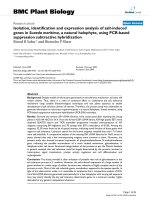
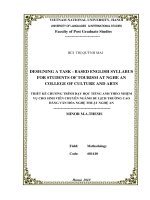
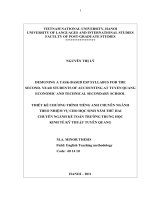
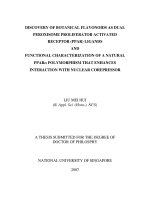

![DSpace at VNU: An efficient and green method for regio- and chemo-selective Friedel-Crafts acylations using a deep eutectic solvent ([CholineCl][ZnCl2](3))](https://media.store123doc.com/images/document/2017_12/16/medium_llu1513419717.jpg)

